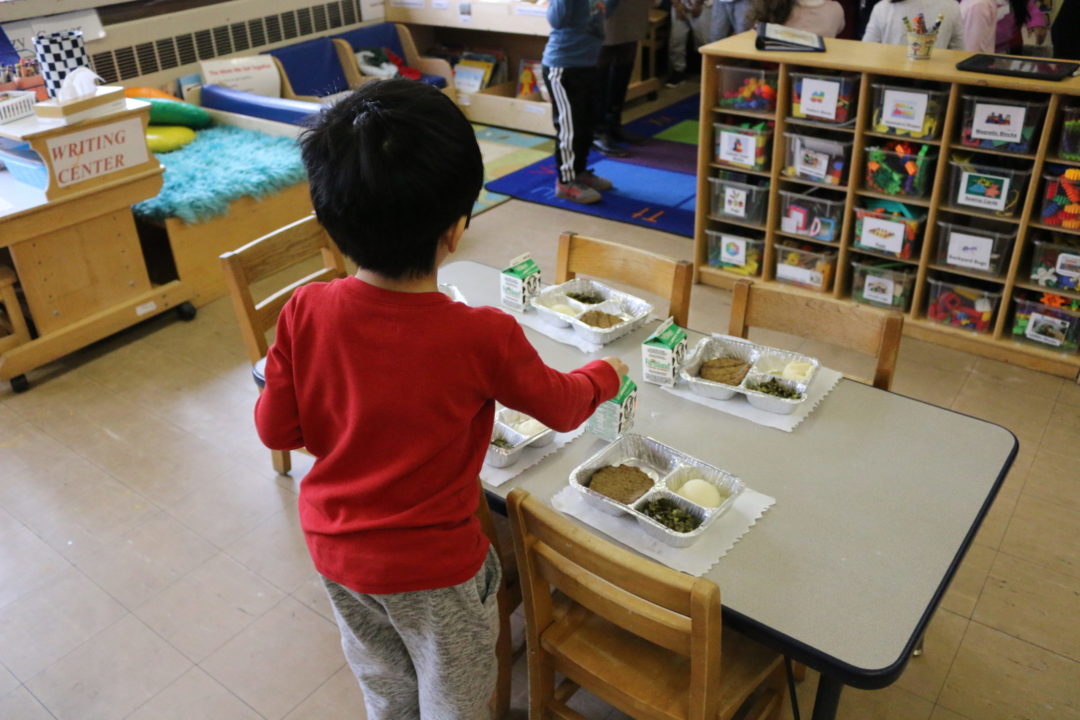Christina Veiga, Chalkbeat New York.
The following article, “Here’s why coronavirus could complicate efforts to keep NYC students fed during school closures,” was originally published on March 12, 2020 by Chalkbeat, a nonprofit news organization covering public education. New York Governor Andrew Cuomo announced on March 15 that NYC schools would close and transition to remote learning. Now, the Tisch Food Center is working with partners across the city and country to track how school districts are ensuring that all children who need them are able to access nutritious meals during this unprecedented time.
The spread of coronavirus forced the first closures of district schools in New York City on Thursday, and the city education department moved quickly to serve bagged meals at the Bronx campus.
Most students at the schools — The Laboratory School of Finance and Technology, and South Bronx Preparatory — cannot afford to pay for their own breakfasts and lunches, highlighting a key reason why Mayor Bill de Blasio has been reluctant to cancel classes even as confirmed cases of the virus climb upwards. Most New York City students rely on school cafeterias to eat three meals a day: More than 70% qualify for free or reduced price lunch, based on their family’s income.
The city has pledged to continue feeding students in the event of school closures. That is daunting even in the best of times, but the threat of the coronavirus means the city will have to tackle new challenges, balancing how to provide nutrition to students while limiting potential exposure to COVID-19.
To do that, the city is offering free “grab and go” meals. Recent online menus show such options have included hummus as a lunch option, while breakfast often includes a bag with fresh or canned fruit, mini cereal boxes, muffins or yogurt. But switching to the to-go model on a large scale — if school closures mount — would likely require a massive shift in how the city’s Office of Food and Nutrition Services serves students.
More than 900,000 meals are served every day in schools, said Liz Accles, executive director of Community Food Advocates, an anti-hunger organization.
“The response has to be on the scale of the problem,” she said. “It is going to be, logically and operationally, hugely challenging.”
Communicating availability of meals and making them accessible will be key.
Many students live far from their schools, which might make it difficult for them to pick up meals. In a system with so much school choice, about 40% of kindergartners do not attend their neighborhood school, according to the Center for New York City Affairs at the New School. And more than 100,000 New York City students are homeless or live in temporary housing, which often means traveling long distances from shelters on public transit to get to class.
Compounding those factors is the possibility that entire families may be quarantined, limiting their ability to leave their homes to pick up food.
The city should also plan for the possibility that school cafeteria workers could be infected or unable to work because their own children need to be cared for while they are home from school.
Claire Raffel, deputy director of the Laurie M. Tisch Center for Food, Education and Policy at Teachers College, said the city should start to think about ways to get meals to students who might not be able to travel to school sites. In a Washington district, an online platform was set up for families to order meals, and school buses delivered them to dozens of designated sites, Raffel said.
She called New York City’s school system “expert,” when it comes to feeding students, and said she trusts officials here to navigate the hurdles. Solutions might even include turning to the city’s numerous app-based food delivery services.
“This is New York City. We have every food delivery system in the world,” she said. “We should be able to figure something out for families who can’t walk to a school and pick something up.”
Some school communities have already sprung into action. When a school in Chicago closed this past weekend, parents began organizing a food pantry, and a charter school in Long Island City has reportedly been distributing dried pasta, granola bars and other nonperishables to families to prepare for a possible closure.
School systems must follow strict federal guidelines when it comes to school meals, so much of what will be possible will depend on the U.S. Department of Agriculture. This week, Agriculture Secretary Sonny Perdue told the School Nutrition Association’s legislative conference that the federal government is working with school systems.
“If schools are closed, we are going to do the very best we can with the tools we have to get those kids fed,” he said.
Advocates want to see federal leaders allow families to pick up more than one meal at a time in order to limit their potential exposure to the virus while traveling to-and-from school, and interacting with staff at distribution sites.
During the outbreak of the H1N1 swine flu, the department allowed states to give SNAP benefits to families with children who qualified for subsidized meals and whose schools were closed — something officials may want to consider this time around.
“There are kids who are going to be made more vulnerable by this and we need to think about ways to help them,” Raffel said.
